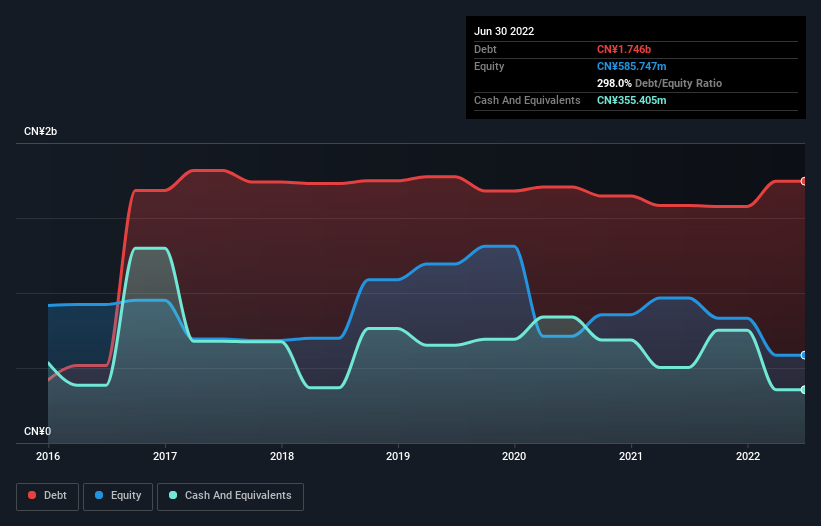- Hong Kong
- /
- Medical Equipment
- /
- SEHK:2393
Yestar Healthcare Holdings (HKG:2393) Seems To Be Using A Lot Of Debt

The external fund manager backed by Berkshire Hathaway's Charlie Munger, Li Lu, makes no bones about it when he says 'The biggest investment risk is not the volatility of prices, but whether you will suffer a permanent loss of capital.' When we think about how risky a company is, we always like to look at its use of debt, since debt overload can lead to ruin. We can see that Yestar Healthcare Holdings Company Limited (HKG:2393) does use debt in its business. But the more important question is: how much risk is that debt creating?
What Risk Does Debt Bring?
Generally speaking, debt only becomes a real problem when a company can't easily pay it off, either by raising capital or with its own cash flow. Part and parcel of capitalism is the process of 'creative destruction' where failed businesses are mercilessly liquidated by their bankers. However, a more usual (but still expensive) situation is where a company must dilute shareholders at a cheap share price simply to get debt under control. Of course, plenty of companies use debt to fund growth, without any negative consequences. The first thing to do when considering how much debt a business uses is to look at its cash and debt together.
See our latest analysis for Yestar Healthcare Holdings
How Much Debt Does Yestar Healthcare Holdings Carry?
As you can see below, at the end of June 2022, Yestar Healthcare Holdings had CN¥1.75b of debt, up from CN¥1.58b a year ago. Click the image for more detail. However, it does have CN¥355.4m in cash offsetting this, leading to net debt of about CN¥1.39b.

How Strong Is Yestar Healthcare Holdings' Balance Sheet?
According to the last reported balance sheet, Yestar Healthcare Holdings had liabilities of CN¥2.00b due within 12 months, and liabilities of CN¥1.61b due beyond 12 months. Offsetting these obligations, it had cash of CN¥355.4m as well as receivables valued at CN¥1.46b due within 12 months. So its liabilities outweigh the sum of its cash and (near-term) receivables by CN¥1.79b.
This deficit casts a shadow over the CN¥836.6m company, like a colossus towering over mere mortals. So we definitely think shareholders need to watch this one closely. After all, Yestar Healthcare Holdings would likely require a major re-capitalisation if it had to pay its creditors today.
In order to size up a company's debt relative to its earnings, we calculate its net debt divided by its earnings before interest, tax, depreciation, and amortization (EBITDA) and its earnings before interest and tax (EBIT) divided by its interest expense (its interest cover). This way, we consider both the absolute quantum of the debt, as well as the interest rates paid on it.
Yestar Healthcare Holdings shareholders face the double whammy of a high net debt to EBITDA ratio (8.2), and fairly weak interest coverage, since EBIT is just 0.23 times the interest expense. The debt burden here is substantial. Worse, Yestar Healthcare Holdings's EBIT was down 87% over the last year. If earnings continue to follow that trajectory, paying off that debt load will be harder than convincing us to run a marathon in the rain. There's no doubt that we learn most about debt from the balance sheet. But it is future earnings, more than anything, that will determine Yestar Healthcare Holdings's ability to maintain a healthy balance sheet going forward. So if you're focused on the future you can check out this free report showing analyst profit forecasts.
Finally, a business needs free cash flow to pay off debt; accounting profits just don't cut it. So the logical step is to look at the proportion of that EBIT that is matched by actual free cash flow. Happily for any shareholders, Yestar Healthcare Holdings actually produced more free cash flow than EBIT over the last three years. That sort of strong cash conversion gets us as excited as the crowd when the beat drops at a Daft Punk concert.
Our View
To be frank both Yestar Healthcare Holdings's EBIT growth rate and its track record of staying on top of its total liabilities make us rather uncomfortable with its debt levels. But on the bright side, its conversion of EBIT to free cash flow is a good sign, and makes us more optimistic. It's also worth noting that Yestar Healthcare Holdings is in the Medical Equipment industry, which is often considered to be quite defensive. Overall, it seems to us that Yestar Healthcare Holdings's balance sheet is really quite a risk to the business. For this reason we're pretty cautious about the stock, and we think shareholders should keep a close eye on its liquidity. When analysing debt levels, the balance sheet is the obvious place to start. However, not all investment risk resides within the balance sheet - far from it. For example - Yestar Healthcare Holdings has 3 warning signs we think you should be aware of.
If, after all that, you're more interested in a fast growing company with a rock-solid balance sheet, then check out our list of net cash growth stocks without delay.
New: Manage All Your Stock Portfolios in One Place
We've created the ultimate portfolio companion for stock investors, and it's free.
• Connect an unlimited number of Portfolios and see your total in one currency
• Be alerted to new Warning Signs or Risks via email or mobile
• Track the Fair Value of your stocks
Have feedback on this article? Concerned about the content? Get in touch with us directly. Alternatively, email editorial-team (at) simplywallst.com.
This article by Simply Wall St is general in nature. We provide commentary based on historical data and analyst forecasts only using an unbiased methodology and our articles are not intended to be financial advice. It does not constitute a recommendation to buy or sell any stock, and does not take account of your objectives, or your financial situation. We aim to bring you long-term focused analysis driven by fundamental data. Note that our analysis may not factor in the latest price-sensitive company announcements or qualitative material. Simply Wall St has no position in any stocks mentioned.
About SEHK:2393
Yestar Healthcare Holdings
An investment holding company, manufactures and sells medical imaging products in Mainland China.
Adequate balance sheet with acceptable track record.
Market Insights
Community Narratives



